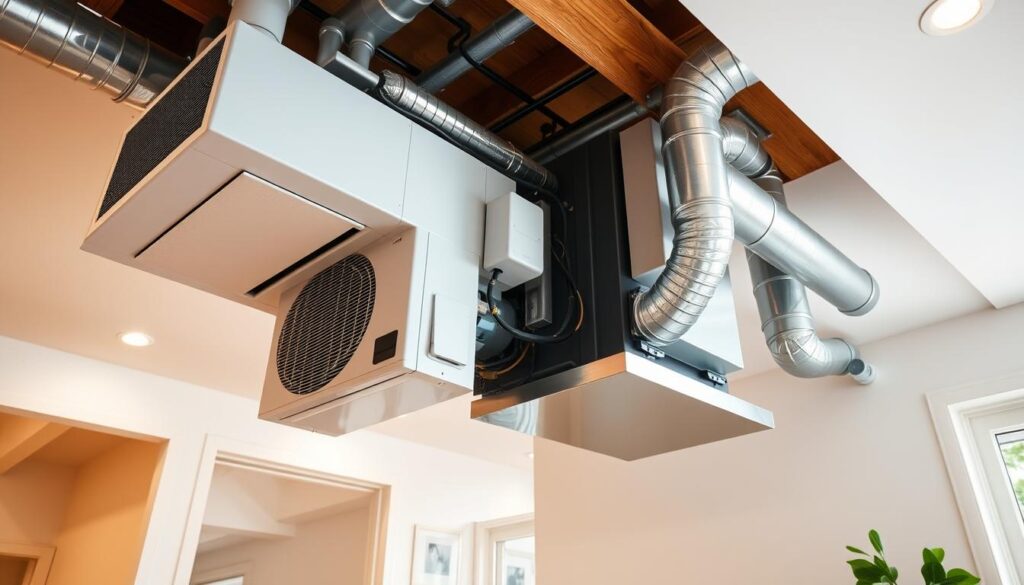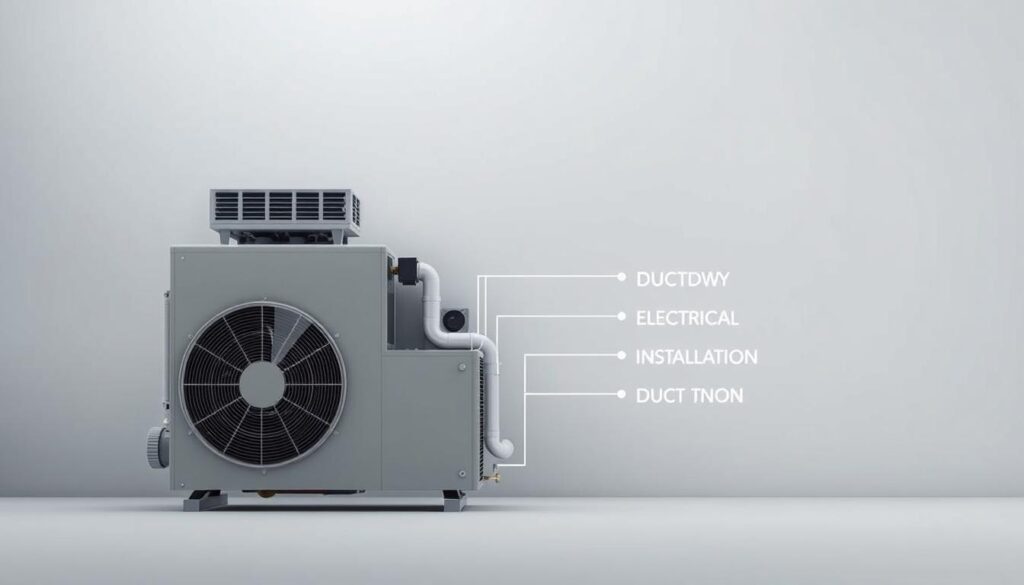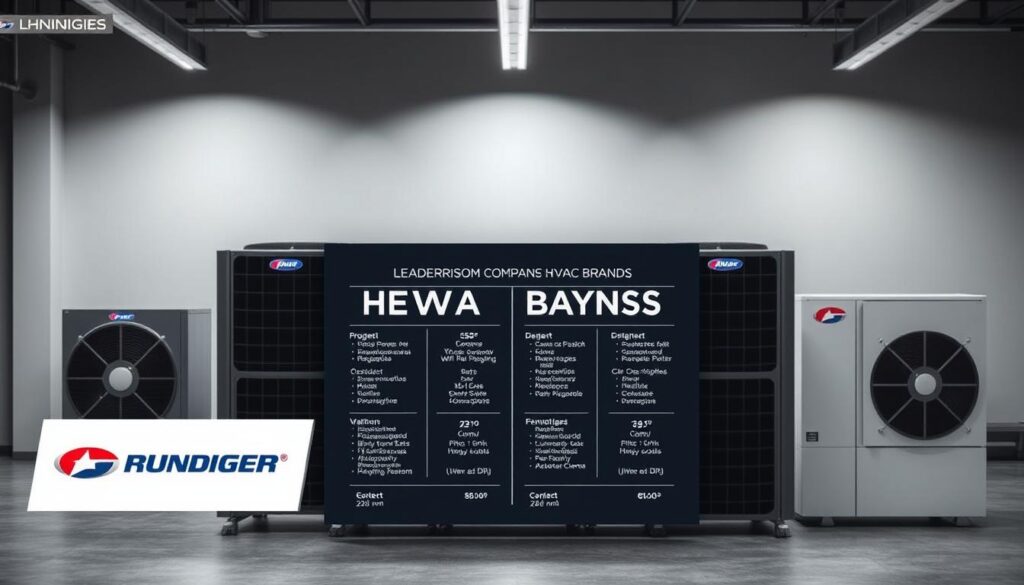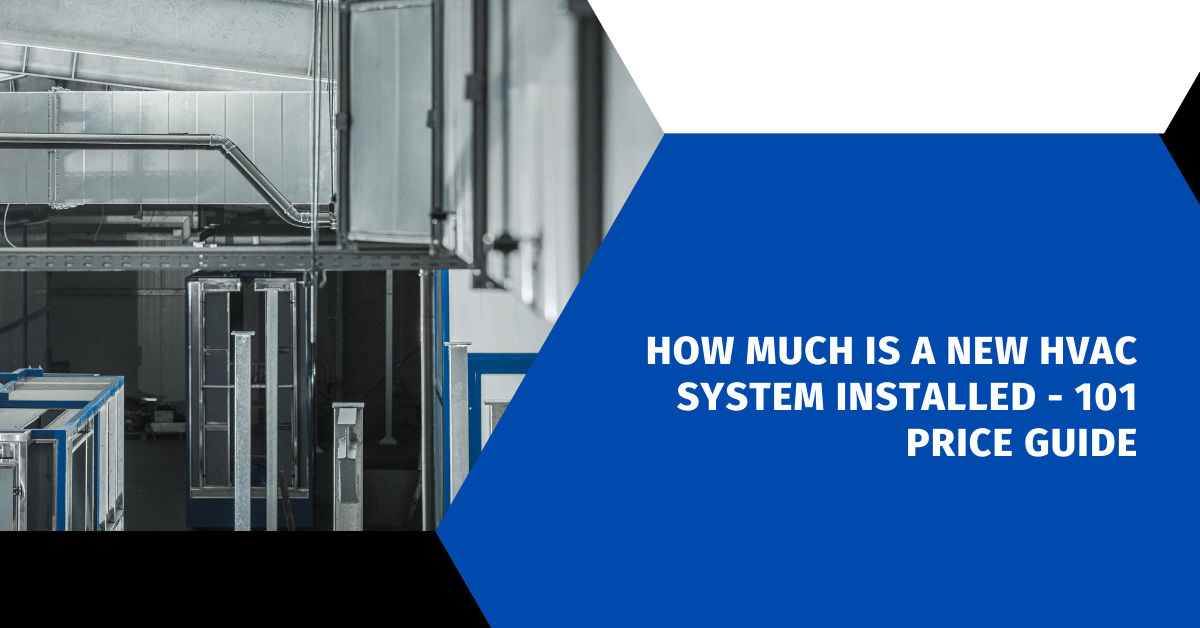Affiliate Disclosure
HVAC Guide Guys is a participant in the Amazon Services LLC Associates Program, an affiliate advertising program designed to provide a means for sites to earn advertising fees by advertising and linking to Amazon.
How Much Is A New HVAC System Installed? Are you tired of high energy bills and uneven home temperatures? Knowing the cost of a new HVAC system could bring you comfort and savings.

Homeowners face a complex pricing landscape when considering a new HVAC system. Costs vary based on your home’s size and local climate.
Modern HVAC systems do more than just control temperature. They’re advanced systems that improve your home’s comfort and energy use.
This guide will help you understand HVAC system investments. It aims to balance initial costs with long-term performance.
Key Takeaways
- HVAC installation costs range from $5,000 to $12,000 on average
- System efficiency directly impacts long-term energy expenses
- Professional installation ensures optimal system performance
- Regional climate significantly influences HVAC system selection
- Energy rebates can offset initial installation expenses
Table of Contents
Understanding HVAC System Components and Installation Basics
When you think about getting a new HVAC system, knowing the parts and how to install them is key. Modern HVAC systems are complex. They have many parts that work together to keep your home at a comfortable temperature.
Modern HVAC systems have several important parts. These parts help control your home’s climate:
- Outdoor condensing unit
- Indoor air handler
- Ductwork system
- Thermostat
- Refrigerant lines
Essential System Requirements
Before you install a new HVAC system, you need to check a few things. Your home must have:
- Good electrical setup
- Enough space for the equipment
- Good insulation
- Ductwork that fits
Professional Installation vs DIY Approaches
Some people might want to install the system themselves to save money. But, hiring a pro has big benefits. Experts make sure:
- The equipment fits right
- The refrigerant is charged correctly
- The system works well
- It meets local building codes
Professional installers help you deal with the technical stuff. They make sure your system works great. This can save you money on energy costs over time.
Explore Our HVAC Shop
Looking for top-rated HVAC tools, parts, and accessories? Visit our shop and find the perfect solution for your needs.
Visit the ShopHow Much Is A New HVAC System Installed
Knowing the costs of installing a new heating and air conditioning system is key to planning your budget. The cost of replacing an HVAC unit can vary a lot. This depends on several important factors that affect your total cost.
When you’re planning to replace your HVAC system, you’ll face different costs. These costs add up to the total price. Let’s look at the main cost factors to help you understand your financial situation better.
Average Installation Costs by Region
The cost of installing an HVAC system changes a lot across the United States. Where you live is a big factor in the cost of replacing your HVAC unit.
- Northeastern states: Higher labor and equipment costs
- Southern regions: More competitive pricing due to year-round demand
- Midwestern areas: Moderate installation expenses
- Western states: Variable costs depending on local market conditions
Labor Costs and Time Estimates
Installing a heating and air conditioning system needs skilled labor and time. The complexity of your project affects the labor costs.
| Installation Type | Average Labor Hours | Estimated Labor Cost |
|---|---|---|
| Central Air Conditioning | 8-12 hours | $1,500 – $2,500 |
| Heat Pump System | 10-14 hours | $2,000 – $3,500 |
| Ductless Mini-Split | 4-6 hours | $800 – $1,500 |
Additional Installation Expenses
There are extra costs beyond the basic equipment and labor:
- Ductwork modifications
- Electrical system upgrades
- Permit and inspection fees
- Old system removal
- Potential structural adjustments
By carefully considering these factors, you can make a detailed budget for your HVAC system replacement. This way, you won’t face any surprise costs.
Explore Our HVAC Shop
Looking for top-rated HVAC tools, parts, and accessories? Visit our shop and find the perfect solution for your needs.
Visit the ShopCentral Air Conditioning System Costs
When you think about getting a central air system, knowing the costs is key. The price for a central air system can change a lot. It usually costs between $3,500 and $7,500 for a full install.
The cost depends on a few important things:
- Home square footage
- System efficiency ratings
- Local climate conditions
- Existing ductwork infrastructure
The size of the cooling system also affects the price. Here’s a look at typical sizes and costs:
| System Size (Tons) | Home Square Footage | Average Installation Cost |
|---|---|---|
| 2 Ton | 1,000-1,500 sq ft | $3,500-$4,500 |
| 3 Ton | 1,500-2,000 sq ft | $4,500-$5,500 |
| 4 Ton | 2,000-2,500 sq ft | $5,500-$6,500 |
| 5 Ton | 2,500-3,000 sq ft | $6,500-$7,500 |
When planning for your central air, remember that more efficient systems cost more at first. But, they save a lot on energy bills over time. Choosing a high-efficiency system with a SEER rating of 16 or above can cut cooling costs by up to 30%.
Talking to a professional HVAC contractor is a good idea. They can find the best option for your home and budget. They’ll give you a detailed estimate based on your needs and local prices.
Heat Pump Installation Pricing Guide
Heat pumps are a smart choice for your home’s heating and cooling. They are more energy-efficient than traditional systems. Knowing the costs and options helps you decide what’s best for your home.
There are different types of heat pumps, each with its own price and installation needs. Your choice depends on your home, local weather, and your budget.
Air Source Heat Pump Costs
Air source heat pumps are the most budget-friendly option. Prices vary:
- Basic models: $3,500 – $6,000
- Mid-range systems: $6,000 – $10,000
- High-end units: $10,000 – $15,000
Ground Source Heat Pump Expenses
Ground source heat pumps need more work to install but save a lot of energy. They cost more upfront:
- Standard residential installation: $10,000 – $25,000
- Complex ground loop systems: $25,000 – $40,000
Ductless Mini-Split System Pricing
Ductless mini-split systems are great for homes without ducts. Prices depend on:
- Single-zone systems: $2,000 – $5,000
- Multi-zone configurations: $5,000 – $12,000
Pro tip: Remember to think about energy savings when looking at heat pump costs. Many systems can cut down on your utility bills over time.
Gas Furnace Installation Expenses
Gas furnaces are a key heating option for many homes in America. The cost for a new gas furnace ranges from $2,500 to $5,000. This price depends on several important factors.
The cost of installing a gas furnace varies for many reasons. The size of your home, the state of your ductwork, and your local climate are all factors. These elements help determine the final cost.
- Furnace size and BTU capacity
- Energy efficiency ratings
- Brand selection
- Installation complexity
Different types of furnaces have different prices. Standard-efficiency models are often cheaper at first. But, high-efficiency furnaces save more money on energy over time.
| Furnace Efficiency | Average Cost Range | Annual Energy Savings |
|---|---|---|
| 80% AFUE | $2,500 – $3,500 | Standard Savings |
| 95% AFUE | $3,500 – $5,500 | High Energy Savings |
Experts say it’s smart to think about your heating needs. Talking to local HVAC pros can help find the best price for your home’s specific needs.
Explore Our HVAC Shop
Looking for top-rated HVAC tools, parts, and accessories? Visit our shop and find the perfect solution for your needs.
Visit the ShopFactors Affecting HVAC Installation Costs
Knowing what affects hvac installation cost helps you choose wisely for your home. Many things influence the price of a new HVAC system.

Homeowners need to think about several important factors. These can greatly change how much you’ll spend on your heating and cooling:
- Home Size and Configuration
- The size of your home affects the system’s power
- Complex homes need more work to install
- Multi-level homes might need extra ducts
- Energy Efficiency Ratings
- Systems with higher SEER ratings cost more upfront
- But, they save money on energy in the long run
- There might be tax breaks for energy-saving systems
Local Climate Impact on Installation
Your location is key in determining hvac installation cost. Different areas need special systems for their weather:
- Hot, humid places need strong dehumidifiers
- Cold areas need efficient heaters
- Coastal areas need systems that resist corrosion
Additional Cost Considerations
When you’re replacing your home’s HVAC, remember these extra costs:
- The state of your current ductwork
- If your electrical system can handle the new system
- Local building codes
- If you’ll need to change your home’s structure
By looking at these factors, you can guess the total cost of your HVAC installation. This helps you make a better choice for your home’s comfort.
Energy Efficiency and Long-term Cost Savings
When you think about getting a new heating and air conditioning system, think about saving money. Modern systems can cut down on energy use and lower your bills.
The U.S. Department of Energy says high-efficiency heat pumps can make 1.5 to 3 times more energy than they use. This means the cost of your new HVAC can be paid back over time.
- Energy efficiency ratings like SEER and AFUE help measure system performance
- High-efficiency systems can reduce energy consumption by up to 40%
- Proper maintenance extends system lifespan and maintains efficiency
Getting an energy-efficient HVAC system has many advantages:
| Efficiency Level | Annual Energy Savings | Estimated Cost Reduction |
|---|---|---|
| Standard Efficiency | Baseline | N/A |
| High Efficiency | 20-40% | $300-$600 Annually |
| Premium Efficiency | 40-60% | $600-$1000 Annually |
Tip: Choose systems with ENERGY STAR certification for maximum efficiency and possible tax credits.
By focusing on energy efficiency when you install your HVAC, you’ll save money and help the environment for years to come.
Explore Our HVAC Shop
Looking for top-rated HVAC tools, parts, and accessories? Visit our shop and find the perfect solution for your needs.
Visit the ShopHVAC Brand Comparison and Price Ranges
Choosing the right HVAC system means knowing the different brands and their prices. The central air you pick affects your comfort and future costs. Prices vary a lot based on the brand and system quality.

When looking at HVAC options, it’s important to think about the brands in each price range. Each range has its own benefits and downsides for homeowners.
Economy Tier Brands
If you’re watching your budget, there are some good choices in the economy tier:
- Goodman: Known for affordable pricing
- Armstrong: Offers budget-friendly solutions
- Payne: Provides cost-effective HVAC systems
Mid-Range Options
Mid-range brands offer a good mix of quality and price:
| Brand | Average Cost Range | Key Features |
|---|---|---|
| Rheem | $3,500 – $6,000 | Reliable performance, good warranty |
| Carrier | $4,000 – $7,500 | Enhanced energy efficiency |
| York | $3,200 – $5,800 | Solid durability, competitive pricing |
Premium HVAC Manufacturers
If you want the best, premium brands offer top-notch quality:
- Lennox: Industry-leading energy efficiency
- Trane: Exceptional durability and advanced technology
- American Standard: Premium engineering and reliability
Remember, your specific needs will guide you to the best brand for your home. Think about your local climate, home size, and budget when choosing.
Explore Our HVAC Shop
Looking for top-rated HVAC tools, parts, and accessories? Visit our shop and find the perfect solution for your needs.
Visit the ShopGovernment Rebates and Incentive Programs
When you think about getting a new HVAC system, knowing about government rebates can help a lot. The U.S. has many programs to help homeowners save money on HVAC replacements.
Federal and state governments offer financial help for energy-efficient HVAC systems. This includes:
- Energy Star Tax Credits
- Local utility rebate programs
- State-specific energy efficiency incentives
- Federal Residential Renewable Energy Tax Credits
The Inflation Reduction Act of 2022 brought big tax credits for homeowners. You could save up to 30% on installation costs with these programs.
“Investing in energy-efficient HVAC systems not only reduces your carbon footprint but can also provide significant financial benefits,” says the U.S. Department of Energy.
To save money on a new HVAC system, follow these steps:
- Research current federal tax credits
- Check local utility company rebates
- Verify state-level energy efficiency programs
- Consult with hvac replacement services about available incentives
Remember, rebate programs often change. Keeping up with the latest incentives can help you save more on your HVAC investment.
Conclusion
Understanding the cost of HVAC installation is key. Your new system’s price is a big deal for your home’s comfort and energy use. Knowing what affects system choice helps you find a balance between cost and performance.
Getting a pro to install your new HVAC is essential. Even though it might cost a lot upfront, it can save you money in the long run. This is because it uses less energy and needs fewer repairs. Choosing a system that fits your local climate is also important for saving money.
Energy efficiency should be your top priority. New HVAC systems have tech that cuts down on your bills. Look into government rebates to help with the cost. Also, keeping your system in good shape is vital for its performance and life.
Your HVAC system is more than just heating and cooling. It’s an investment in your home’s comfort and the environment. By looking at all your options, getting quotes from pros, and focusing on long-term benefits, you can get a system that’s right for your home.

